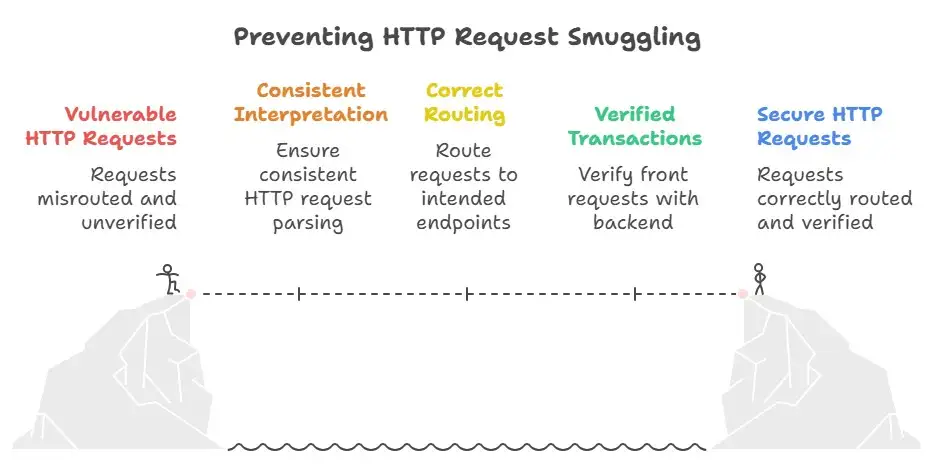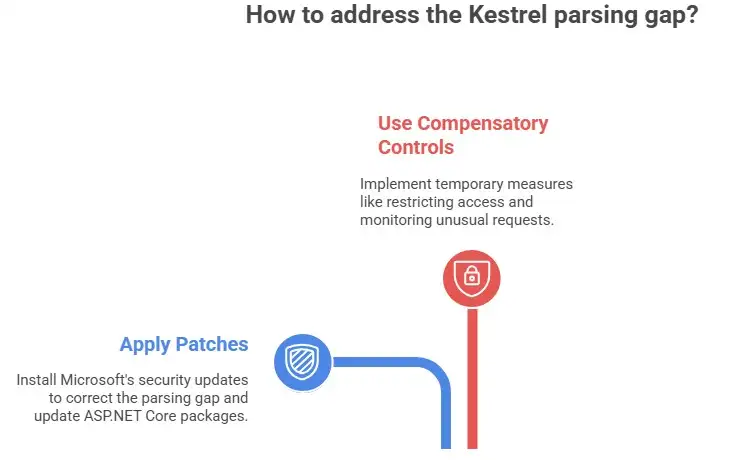Critical ASP.NET Core Vulnerability Exposed

Hoplon InfoSec
21 Oct, 2025
A hacker could conceal a harmful request inside a benign one if a web server misreads a line of text. This month, a regular web server made the news because of this kind of weak logic.
In short, Microsoft warned that ASP.NET Core has a big security weakness that lets an attacker who is already logged in get an extra HTTP request past the server's protections.
If someone takes advantage of a hole in the Kestrel web server component, they could get around built-in security checks and possibly see private information, cause crashes, or make changes that aren't authorized.
Why this is crucial now
This defect is too big to be ignored. The CVE-2025-55315 code was given to the bug, and it was rated very high on severity scales. If companies utilize versions of the framework that are insecure, attackers could get in over the network. Kestrel is used in a lot of ASP.NET Core apps; hence, a lot of sites and services need to be repaired. There were patches in Microsoft's October releases, and developers should regard this as an emergency.
The Technical Idea in Simple Terms
Think about HTTP as the mail that comes to a post office. The clerk usually stamps and sorts each letter so that they know which envelope goes with which letter. Request smuggling is like inserting a second envelope within the first one so that the clerk just examines the exterior envelope and sends the hidden letter to the wrong pile. In Kestrel's example, interpreting some sections of the HTTP request in a way that wasn't consistent permitted a second request to go through paths that should have prevented it.
This kind of confusion has happened previously in web infrastructure, but it's not normal to find it in a server component that runs so many .NET apps. As a result of the misrouting, an attacker may be able to go to endpoints they shouldn't be able to reach or combine a front request that hasn't been verified with a backend transaction that has. The end result is that security mechanisms that assume correct request boundaries can be bypassed.

Who may use it, and how hard is it?
This is not something that anyone can get to from anywhere. For the vulnerability to work, the attacker has to be logged in and have at least basic access to the application they are trying to attack. In other words, an attacker needs to log in or already have access to a low-level account on the site.
Then, they need to make a specific HTTP sequence to get in an extra request. That makes the blast radius smaller immediately, but it doesn't make it safe. A lot of sites contain features that let attackers in, like signing up, resetting passwords, and webhooks. This vulnerability makes it easy for them to wreak more harm once they get in.
Here are some practical ways that someone could use the weakness to their advantage.
1. A situation in which credentials are made public
If an attacker gets into an account on a multi-tenant system, they could ask the server to provide them information that belongs to another user. That can mean sharing session tokens, API credentials, or personal information.
2. A situation where files are changed
Some programs only let people who are logged in upload files or change content. An attacker might use the smuggling method to mask a request to edit a file that they shouldn't have access to. This could distort the file's content or add harmful code.
3. A situation in which the system crashes and won't work
The flaw can at least be leveraged to submit bad requests that crash the server. An attacker can make sequences that cause the app to crash or run out of resources, which means that genuine users can't utilize the service.
Developer Actions
The most important thing is to update. Microsoft issued patches that correct the parsing gap by changing the way Kestrel works and updating ASP.NET Core packages. Teams should look for programs that use old versions that are known to be unsafe and rapidly install the vendor upgrades.
After that, they should test the modification in staging and then deploy it into production as quickly as they can. If you use managed hosting or containers, make sure that the base images and the images in your pipeline are the patched runtime versions.
Use compensatory controls if you can't patch straight away. Restrict access to authentication endpoints, keep an eye on unusual request sequences, and build up web application firewalls with rules that look for patterns of smuggling.
Remember that WAFs don't always stop these attacks since they take advantage of how gateways and backends interpret data in different ways. Keeping an eye on things and fixing them fast is still the best defense.
A brief list
1. A list of apps that work with Kestrel and ASP.NET Core.
2. For CVE-2025-55315, use Microsoft's security updates.
3. Test the paths for authentication and handling requests in staging.
4. Check the logs for odd pairs of requests or parse failures.
5. Make accounts with low privileges safer and limit what they can do in public.

Why This Matters for Overall App Security
These kinds of bugs reveal that the whole ecosystem has security problems. The only way to take advantage of a server parser's weakness is because other portions of the system expect requests to be very limited. Defenders often pay attention to items like authentication, input validation, and encryption. All of those elements are significant, but so are the assumptions that infrastructure makes about how traffic flows at the chain level.
This occurrence reminds us that keeping platforms up to date is a vital element of keeping them safe. Even tiny mistakes in parsing can have significant repercussions. This is a scenario that experienced defenders know: a little problem that looks to be merely a problem in one place can become a concern when it spreads across a network.
Attackers move swiftly, and when a fix is released, there are often public write-ups and proof-of-concept code. When the specifics are out in the open, less experienced people can use the method as a weapon. That's why the period between vendor patches and your deployment, as well as the update cadence, is problematic. The longer you delay upgrading server components, the more likely you are to find an exploited instance.
Don't wait until "sometime next month" to make important improvements to your framework. Give them the same level of attention as urgent operational work.
Balancing Diligence and Urgency
It's crucial to test as well as patch promptly. If you don't take your time with an upgrade, it could damage compatibility or screw up middleware, which could create outages. This is the best way to accomplish it: Set up the update, run smoke tests on authentication, file handling, and any custom middleware that works with raw request bytes, and then push it out with monitoring and the option to turn back. Talk to your staff and consumers so that disruptions can be managed well.
Post-Patch Monitoring for Security Teams
After you patch, look in the logs for clues that the problem was there before the remedy.
Focus on:
• 5xx errors that occur at odd times throughout attack windows.
• Requests with strange combinations of headers or difficulties with the length of the content that keep happening.
• Logs of authentication that reveal unusual sequences from accounts that have been validated.
These artifacts can still demonstrate that someone tried to smuggle something or did after the code was repaired. Logging that saves raw request details for a limited time can be highly useful during an inquiry.
I've worked in the field and patched services that had similar parsing problems before. The pattern never changes. At first, people don't believe it. Then they get intrigued by the technology and hurry to fix it and check it out. The human factor is what keeps me up at night. A lot of teams don't update because they're worried about breaking stuff.
That makes sense. But based on what I've seen, the biggest danger is not resolving important security holes. I appreciate short, controlled update cycles and automated tests that test the bounds of protocols. It might not be as fun as working on new features, but it's a lot more helpful when things go wrong.
Last thoughts
In short, the new ASP.NET Core vulnerability shows a fault in the parser that lets an authenticated attacker get around security protections by utilizing HTTP request smuggling. You should take it seriously, fix Kestrel and the ASP.NET Core packages, and look through your logs for indicators of exploitation. If you have a lot of cars, automate your inventory and patching so you don't have to go through spreadsheets by hand in an emergency like this.
Things you can do right now
1. Look for apps that use old, unsafe versions of ASP.NET Core.
2. Upgrade to the vendor's recommended versions for CVE-2025-55315.
3. Watch for patterns in smuggling and ask for limits that come up out of nowhere.
4. Check the workflows for accounts with low privileges and make them as strong as you can.
Hoplon Infosec can help with Web Application Security Testing, identifying vulnerabilities like this ASP.NET Core flaw and securing your apps before attackers exploit them.
Follow us on X (Twitter) and LinkedIn for more cybersecurity news and updates. Stay connected on YouTube, Facebook, and Instagram as well. At Hoplon Infosec, we’re committed to securing your digital world.
Share this :